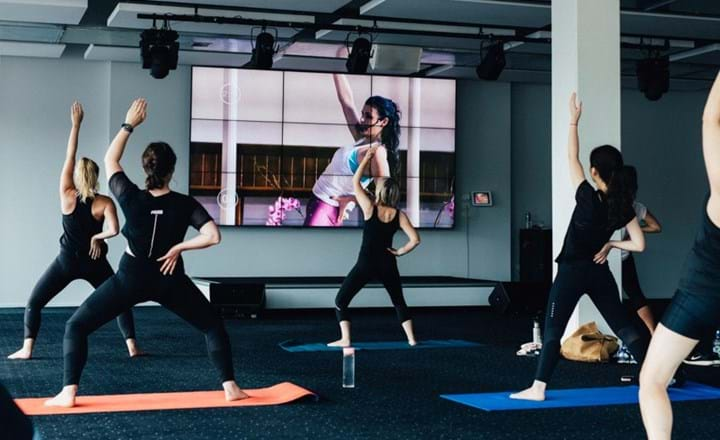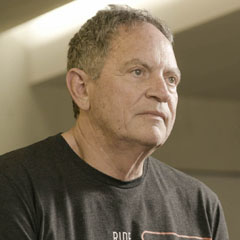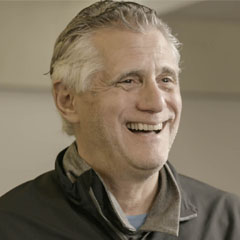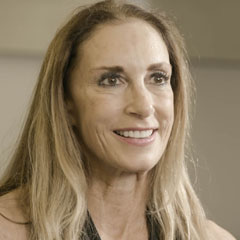
What’s the next big thing in fitness? It’s the perennial question for every club operator. If presentations and panels at the recent IHRSA and FIBO trade shows are anything to go by, this year looks set to become the year of Virtual.
Having enjoyed significant growth in recent years, Virtual Fitness solutions are now estimated to be present in 12,000 health clubs worldwide as operators embrace the potential of digital solutions. And the trend is gaining traction with gym-goers too. According to industry research, 60 per cent of members state the number of group exercise classes offered by a gym influences their decision to join, while 75 per cent of gym members who haven’t tried Virtual Fitness are considering it.
Early club adopters have been quick to pinpoint the benefits of Virtual, and several are tipping the solution to soon become a mainstay for many more facilities.

We have Virtual in all of our Brick Bodies clubs – it’s the next frontier.
“We have Virtual in all of our Brick Bodies clubs – it’s the next frontier,” says Victor Brick, one of Planet Fitness’ biggest franchisees (60 clubs) and Chairman of the Board of Brick Bodies (6 clubs). “People want to work out on their time, not on yours, and virtual allows clubs to provide that without breaking the bank.”
What was once seen as a niche product, hampered by poor content and pallid projectors, is quickly becoming a major attendance driver for clubs which invest in their studio and Virtual solution. At Les Mills Newmarket in New Zealand, for example, virtual classes now account for 23 per cent of club visits, while 70 per cent of all club visits are generated through group exercise.
So how are clubs shifting Virtual from a vanity investment to a significant source of attendances? And is this really the great white hope for fitness studios? Or are operators being blinded by the light? We spoke to major operators from around the world – responsible for almost 1,500 health clubs between them – to ask whether they’re voting virtual and what tactics they’re deploying.
A fixture of the future
While often spoken of as a relatively new phenomenon, many operators consider Virtual to be the natural evolution of a fitness tradition that dates right back to the 1950s.

If you really think about Virtual, it all started with Jane Fonda workout tapes or Jack LaLanne even in the early days of TV.
“If you really think about Virtual, it all started with Jane Fonda workout tapes or Jack LaLanne even in the early days of TV,” says Steve Schwartz, President and CEO of Midtown Athletics Clubs – a chain of eight luxury sports resorts in the US and Canada.
“What’s changing now is the quality and acceptance of virtual – it’s really taking off. I think this year is the tipping point. It started with budget clubs, now it’s moving into luxury clubs and pretty soon it will be in all clubs as members accept it more.”
But while adoption of Virtual is clearly growing among clubs, operators should still think hard over whether it’s the right fit for them, cautions Lynne Brick, co-owner of Brick Bodies Fitness Services.
“It’s a great concept but the market has to be ready for it, so clubs must consider whether programs are suited for the needs of their members. Some of the Virtual classes we’ve offered in our clubs have seen minimal participation, so you have to make sure it’s right.”
Maximize ROI on Studio Space
While fully-functioning studios can be among the most profitable areas of a club (per square metre), group exercise spaces remain a missed opportunity for many clubs. Mintel research from 2017 found the average health club cycle studio stays idle for 83 per cent of the day, which can mean up to US$160,000 per year of lost revenue. So how are club leaders using virtual to counter this?
“A big part of our entire program is group fitness and the percentage of participants is dramatic,” says Mark Harrington, CEO of Healthworks Fitness – a chain of four female-focused US clubs, plus two not-for-profit community fitness centers.

Virtual gives people a chance to come in any time they want and know there is going to be a class.
“That said, even in a club that might have a hundred and fifty classes a week, the studio is empty for several hundred hours a week even with the classes we give. Virtual gives people a chance to come in any time they want and know there is going to be a class.”
For a growing number of operators, empty slots in a studio are something they can ill-afford. And Virtual presents a compelling solution for boosting return on investment.
“You have to take a really strong look at group fitness studios, as they occupy a big percentage of the total space of the club, but are only occupied thirty-five hours a week,” adds Geoff Dyer, President Crunch Fitness West Florida/Orlando/Atlanta.

If you can take that occupancy up to every hour you are open with Virtual Fitness, that gives you a distinct advantage over your competition.
“If you can take that occupancy up to every hour you are open with Virtual Fitness, that gives you a distinct advantage over your competition and Les Mills is the premier option here without a doubt.”
High-quality Studio Fit-Out
One growing area of agreement among operators seems to be the importance of investing in cinematic A/V equipment for a Virtual Fitness studio. As technology has improved and costs have reduced, LED video walls and mosaic screens are now increasingly affordable options for clubs.

For Virtual, it’s vital to have good quality hardware, whether it’s a nine-screen mosaic or one big LED screen.
“For Virtual, it’s vital to have good quality hardware, whether it’s a nine-screen mosaic or one big LED screen,” says Rene Moos, CEO of Basic-Fit (521 clubs across Europe with 1.5m+ membership), which is using the mosaic option to good effect.
“The most important ingredients of a Virtual class are combining music with really inspiring instructors, because you are watching a movie so it needs to feel like you’re really there dancing with the group.”
Steve Schwartz believes faded old projectors and sterile monologues will no longer cut it with club members when it comes to Virtual.
“I think the key to successful virtual is delivering an immersive quality experience,” he adds. “So as a club owner, I’m going to invest in a better sound system and screen. Plus, I’m going to invest in the ambience of the studio so members in a class feel they’re part of a production, rather than alone on a bike in a room.”
Hybrid Studio Offer
The best of in-studio and at-home digital
Quality Content
But while top-rate A/V is half of the battle, operators are clear that world-class content remains the key difference between members loving or leaving a Virtual Fitness studio.

Content is always going to be king, the best content always wins.
“Content is always going to be king, the best content always wins,” says Frank Napolitano, President of 24 Hour Fitness, which operates 440 clubs in the US, boasting almost four million members.
“It does not have to be a single genre of content, but it has to all be brilliant because poor content, like a poor instructor, can kill a program.”
Victor Brick agrees, adding that Virtual content must be as close to a live class as possible to really resonate with members and inspire them to exercise.
“Content is key and it’s still all about the experience – people could work-out at their house on a computer if it was only about the movements,” he adds.
“You want to feel motivated, you want to feel excited and you want to look forward to doing the activity. Great Virtual achieves this by recreating the thrill of a live class experience.”
Gateway to Live Classes
One of the most interesting aspects of Virtual’s future will be its impact on live classes. While some critics have warned that cannibalisation is inevitable, initial indications have shown quite the opposite. Industry research shows attendances in live classes increase by 12 per cent on average when clubs also run Virtual workouts, which appear to act as a gateway to live classes for less confident members.

Virtual is an excellent product for reaching new audiences that perhaps feel too intimidated to take a class with a live instructor.
“Virtual is an excellent product for reaching new audiences that perhaps feel too intimidated to take a class with a live instructor,” says Lynne Brick. “It can also create an opportunity for beginners to welcome themselves into a non-intimidating kind of environment.”
Another criticism of Virtual has been the perceived risk it poses to instructors. However, David Patchell-Evans, Founder and CEO of GoodLife Fitness Clubs (which operates almost 400 clubs across Canada), sees clear communication as key to allaying these fears.
“When we originally put virtual in our clubs, people thought ‘they want to replace me as an instructor,’” he adds.
“But what we actually want to do is get more people into our live classes, so opening the door to a bigger audience means there are then more live class attendees for our instructors to engage, which is great for everyone.”
The end of off-peak
One of the clearest benefits of Virtual is its ability to cover quiet periods with relatively inexpensive class options and put less pressure on the studio during peak periods.
For Steve Schwartz, the key is being able to provide members with more class offerings, while maintaining a high level of quality.
“We’ve been running RPM™ classes virtually alongside other live classes,” he says. “They’re not quite at the same level, but there’s a following for both and a real appreciation for the ability to have a class of that quality in an hour where you really couldn’t afford to have an instructor.”
For clubs, this also means they can enhance the member experience and bring group fitness to new demographics they couldn’t previously reach.
“A lot of my clubs are 24 hours, so I can come in off a shift at 2am and do a Virtual class, when otherwise I could never get to it,” says David Patchell-Evans.

Virtual has helped us drive more people into live classes.
“Virtual has helped us drive more people into live classes. It brings accessibility to people that they did not have before, while also solving the problem of overcrowding at peak times too.”
LES MILLS™ Virtual classes are exciting, cinematic-quality versions of live classes. You get chart-topping music and instruction from the world’s best talent – creating unparalleled virtual experiences.
Want to learn more?
Discover how LES MILLS Virtual can drive new memberships for your club with our free Secrets of Success Implementation Guide.
Download now